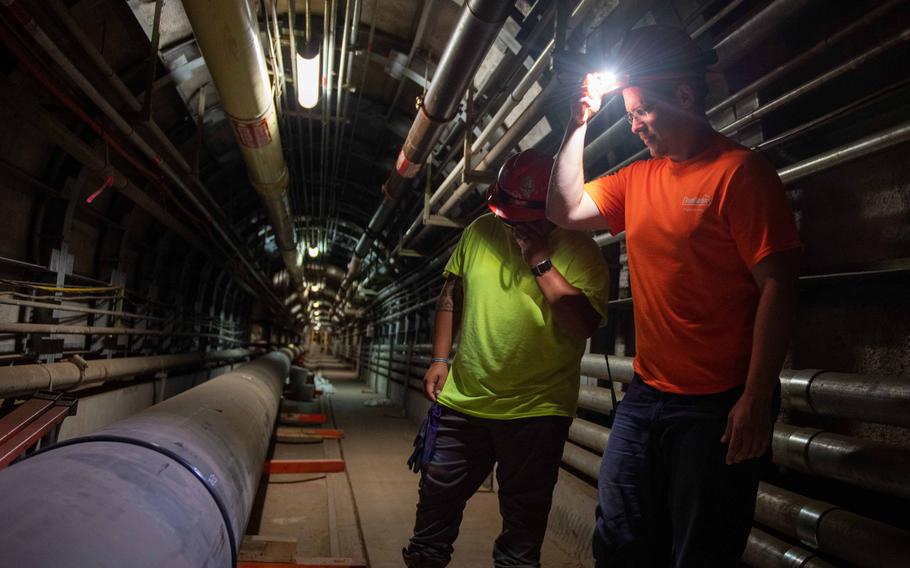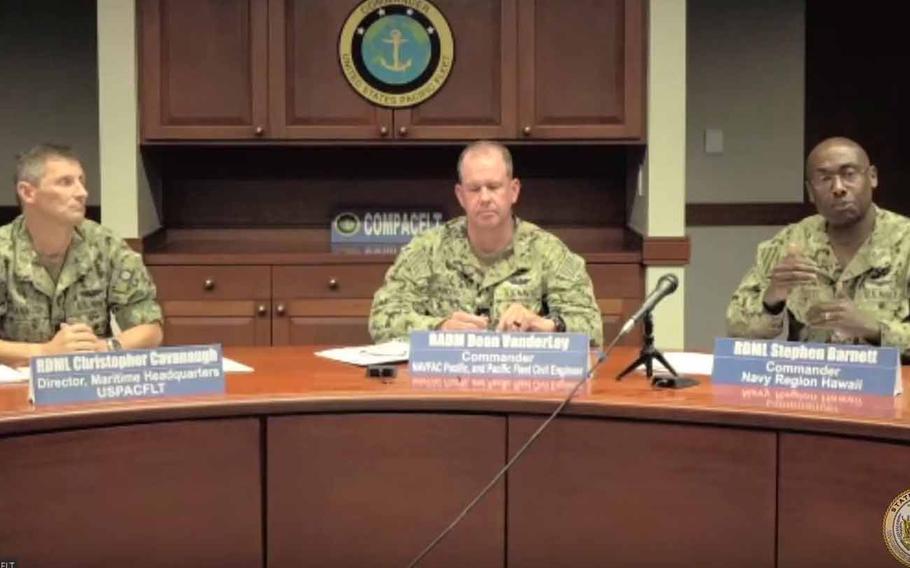
Navy contractors perform a routine inspection on a filtration system at the Red Hill well in Aiea, Hawaii, April 11, 2022. (Mar’Queon A. D. Tramble/U.S. Navy)
FORT SHAFTER, Hawaii — Hawaii lawmakers and health officials have chided Navy officials for delays in providing complete plans for defueling the Red Hill underground fuel storage facility that is the source of drinking water contamination on Oahu.
“[T]he Navy doesn’t seem to have the same sense of urgency that my constituents have and that the state of Hawaii has,” Hawaii Rep. Sonny Ganaden said at a briefing by Navy officials at the statehouse Tuesday.
The Navy submitted a required defueling plan on June 30 to the Hawaii Department of Health, a deadline the state agency had mandated in an emergency order issued early this year calling for the facility’s closure. The deadline for submitting a plan for the facility’s closure is Nov. 1.
Kathleen Ho, director for environmental health at the Health Department, described the Navy’s defueling plan as “disappointing.”
“The Department of Health does not approve the current defueling plan,” Ho said.
Fuel spills in May and November from the facility on the outskirts of Honolulu seeped into the groundwater. Jet fuel contaminated one of three wells used by the Navy in supplying water to thousands of homes on military communities near and on Joint Base Pearl Harbor-Hickam.

Rear Adm. Stephen Barnett, commander of Navy Region Hawaii, right, speaks with Hawaii lawmakers at the Hawaii statehouse in this screenshot of a video of the briefing on July 19, 2022. Beside him are Rear Adm. Christopher Cavanaugh, left, and Rear Adm. Dean VanderLey. (Hawaii State Legislature)
Thousands of residents were displaced for months this winter, with some experiencing a host of symptoms such as rashes, diarrhea, headaches and fatigue.
“The highly anticipated defueling plan was disappointing,” Ho told the three Navy officials providing the briefing, which included Rear Adm. Stephen Barnett, who assumed command of Navy Region Hawaii in June.
“It lacked substance, specific detail and dates,” Ho said.
“We need the Navy to feel the same sense of urgency that we feel and that safely defueling and decommissioning the tanks would be in the best interest of everyone,” she said.
Barnett said that the June submission was intended to provide a “framework” of how the Navy would defuel the facility, which currently holds an estimated 150 million gallons of fuel.
It has not been operational since late November, shortly after residents began complaining of tainted water that was traced to the contaminated well.
“The intention is not to delay the defueling,” Barnett said. “I understand your concerns, but the intent was to have a framework and then as we go through each individual item, provide that as we get through, as we complete those items to kind of supplement the framework, to give a complete document at the end.”
The Navy expects to provide all needed information by Aug. 31.
Pipelines in the facility will require extensive repair before defueling can begin, according to a report by a Navy contractor released in May. Major structural repairs will be needed to the system that connects the tanks to a fueling depot on Pearl Harbor.
The Navy has estimated the defueling will take about a year once those repairs are completed, but the timeframe for repair has not been determined.
The Navy estimates the facility will be closed by the end of 2024.
That timeframe does not sit well with some Hawaiians.
State Sen. Bennette Misalucha said that among the public and state officials “there is a clamor to speed up the process, to accelerate it, that 2024 is not acceptable.”
“Ma’am, we understand that the community wants to expedite this as much as possible,” Barnett said. But the World War II-era Red Hill facility was a “one-of-a-kind” feat of engineering and now requires specialized equipment to be shipped in from the mainland for making repairs, he said.
The design of those repairs is still evolving, said Rear Adm. Dean VanderLey, head of Naval Facilities Engineering Systems Command Pacific.
“As those designs are complete this fall, we will have a much more detailed, critical schedule of all the repairs,” VanderLey said. That could lead to opportunities to shorten the timeline, he said.
“We absolutely would welcome the engagement with the regulatory agencies on how we could continue to do this safely but maybe do it faster,” VanderLey said.